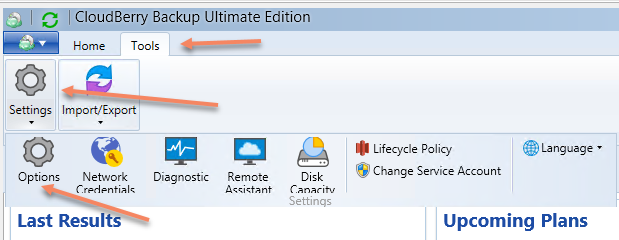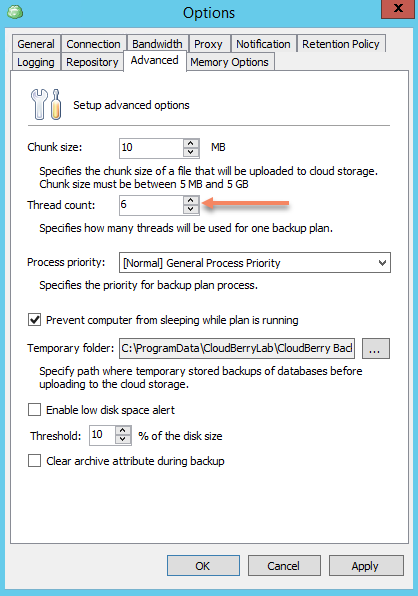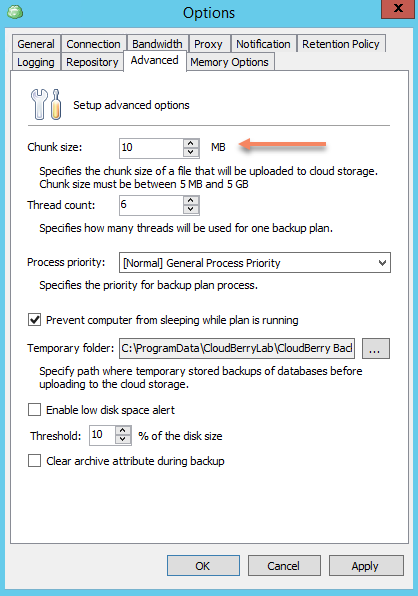MSP360 Backup is designed to provide high backup speed. In some cases, however, the backup process can be slower than expected. In this article, we will take a look at speeding techniques.
Table of Contents
Firewalls and Antivirus Programs
In some cases, firewalls and antivirus programs can become the reason of low backup speed.
Firewalls and antivirus programs can block unknown applications, limit bandwidth and prevent long transfers for them. That means that both of them - firewalls and antivirus programs can lower the speed of backup.
To avoid speed issues related to firewall and antivirus activity, please make sure following executable files are included into the list of trusted applications in your firewall and antivirus settings:
- CBBackupPlan.exe,
- MSP360 Online Backup.exe (or MSP360 Backup Server Edition.exe, MSP360 Backup for MS SQL Server.exe, MSP360 Backup Enterprise Edition.exe, MSP360 Backup Bare Metal Edition.exe, MSP360 Backup for MS Exchange Server.exe)
- Cloud.Backup.Scheduler.exe,
- cbb.exe
To check if the case is really in the antivirus or firewall - try disabling them and start a sample backup job. If the backup is faster - you need to add necessary permissions to the software. We don't recommend running Backups with disabled antivirus or firewall.
Multithreading
MSP360 Backup uploads data using several threads at once. Usually, multithreading speeds things up, but in particular cases - this can be the reason for the slow backup.
Some Internet providers support unlimited thread number but some do not. If your provider has limitations (declared or hidden) on a number of connections, you may face a slow backup speed as a result. If you got your firewall and antivirus off but backup is still slow, take a few following actions to deactivate multithreading feature:
1Run MSP360 Backup;
2Open “Tools” menu and click on the “Options”;
3Go to the “Advanced” tab;
4Set the value in the “Thread count” field to one (1);
5Click “OK”.
If this change takes effect, you can try to change thread count to a greater number to find the best count for your network environment.
Chunk Size
Backup data is transferred over the network in pieces or in other words - "chunks". Transfer of smaller chunk requires less bandwidth than for bigger ones. Using small chunks allows avoiding long reload in case of error during the data transfer to the cloud storage. We recommend setting chunk size on about 10-20 MB. To set up a chunk size, please, follow the short instruction below:
1Run MSP360 Backup;
2Open “Tools” menu and click on the “Options”;
3Go to the “Advanced” tab;
4Set the value in the “Chunk size” field to ten (10);
5Click “OK”.
If you have done everything correctly the speed of backup should come to the normal value. If you still have the speed of backup too low, please, feel free to contact our support team.
Managing Memory Usage
You can have a slow backup when backing up large files or lots of files at the same time. It occurs because MSP360 Backup uses a fixed size of memory that is calculated as threadcount*2*chunksize (e.g. 6*2*10 = 120MB of RAM by default) to load file parts into a memory prior to uploading. If you have more file chunks than memory size allocated, MSP360 Backup starts using a physical memory that slows down the process.
You can manage memory space usage in the following way:
1Go to C:\ProgramData\MSP360 Backup Server Edition\ and find enginesettings.list.
2Open enginesettings.list with Notepad.
3Find a tag: <MemoryManagerMaxMemoryUsage>
and set larger value (in bytes): for example, 1073741824 (this is 1 GB).
4Save changes.
5Run a backup
Your Backup Is Still Not Fast Enough?
If you still have issues with backup speed - don't hesitate asking for help at our official MSP360 Forum or in the comments below.




